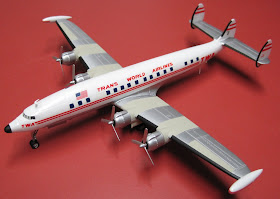
One of my all-time favorite model kits: the Revell 1/32 scale Hughes OH-6A Cayuse helicopter. This is my fourth build of this kit since 1975. The first time I saw this model was at a toy store in a San Fernando Valley mall. The box art really appealed to me (it still does) and the sleek, but egg-shaped look of the OH-6A has made this helicopter my favorite over all others.

I don't remember painting my first one, but I bought another one a couple years later - 1977 perhaps, and painted it according to the directions. I built a third one about two years ago, straight from the box, and it looked exactly like the fourth one pictured here. I enjoy building this model a little bit more each time. Perhaps I'll build another one; but next time I'll do the civilian Hughes 500 version with red seats and tan interior.
What I've always liked about this model is the detailed interior. The military version has drop down canvas seat packs moulded into the rear bulkhead piece. An ammo box is glued to the rear floor, and some sort of fake-looking gun sight is glued onto the center bulkhead, between the two pilot seats. I don't know if this model was based on an early concept or prototype drawing of the OH-6A. It wouldn't surprise me since the 1/72 scale OV-10A Bronco kit, released the same year of 1970, is based on the early Marine version. I searched for photos of early OH-6As on the Internet, and I did see a few showing the external Gatling gun in an aerodynamic enclosure, but I couldn't see any large sighting devices between the pilot and gunner's seats. At any rate, I chose to glue it on, since I was sticking to the directions as closely as possible.
One liberty I did take was to paint to canopy framework olive drab, where the directions give no guidance on this. The Hughes 500 and OH-6A have a large panel on the front windshield bubble, with what looks like an air vent and a landing light mounted into it. To leave this large panel clear on the model just doesn't look right. I left the rest of the model in its correctly moulded olive green color - although the plastic is glossy. Color pictures of early OH-6As reveal a semi-gloss olive finish, so leaving the model glossy isn't that big a deal.
The decals are original to the kit, and went on nicely using the Microscale system. MicroSol is necessary to get the "U.S. Army" decal to conform to the plethora of rivets on the tail boom. This is the dilemma one faces when building model kits straight from the box, without any super-detailing.
The parts fit together pretty well on this model; but the biggest weaknesses are the clear window pieces. They are crazed pretty badly from the injection moulding process, and distort the interior when viewing any closer than one foot from the model. They do not fit well either. There are no alignment pins or grooves - they just lay into the window hole from the inside, and the builder is expected to glue them in somehow. Although I'm sure I used tube cement on these windows for my first two models, I used liquid cement on the later two. This works much better, but one has to be careful not to get one iota of glue on the clear pieces, or else the error sticks out like a sore thumb. One could also use Micro Krystal Klear to cement them in, but I would be afraid of accidentally punching them in with the thumb or fingers during handling of the model.
The kit comes with a pilot figure, but he is terrible looking no matter how well you are at painting figures. His arms are moulded along his side, and there is a huge seam that runs around him that must be filled after gluing his two halves together. It ain't worth it! On all but the last three kits I've built of this one, I let the pilot figure go into the trash can still affixed to the runner.
This is a great companion model to Revell's other 1/32 Vietnam U.S. Army helicopter kits such as the Huey and Huey Cobra. Too bad Revell didn't just carry on and release the whole set of Army choppers in 1/32 such as the Chinook, Sioux, Skycrane, and Choctaw, among others.




















.JPG)







